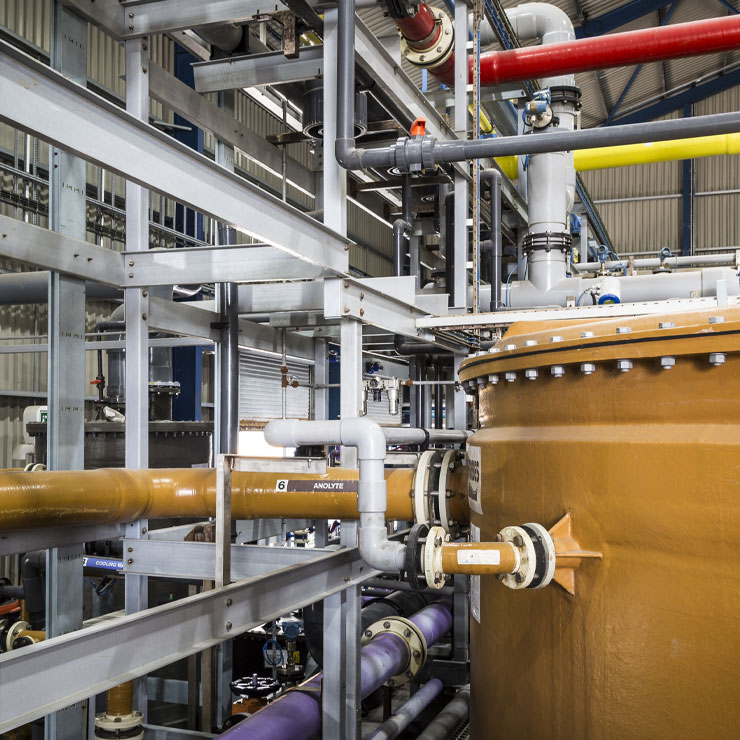
Power & Energy
Electricity generation in the UK has significantly evolved, with a notable increase in the share of renewable energy sources.
As of 2023, natural gas remains a primary source, contributing around 32% of the total electricity supply. However, the use of fossil fuels, including gas and coal, has dropped significantly, with renewables and nuclear energy making substantial contributions. In 2023, renewables provided 43% of the UK’s electricity, driven by wind, solar, biomass and hydroelectric power.
Additionally, biogas and energy from waste have emerged as significant components of the UK’s renewable energy strategy. Biogas, produced from organic waste materials, and energy from waste, which involves converting waste products into usable energy, both contribute to reducing landfill use and greenhouse gas emissions, while providing sustainable electricity and heat.
At ICL, we stand at the forefront of supplying the UK’s power and energy sector, serving major power companies and entities engaged in oil or gas exploration, development, drilling, and integrated power operations.

Power/Energy
Products
Our comprehensive product range caters to diverse needs within this dynamic industry landscape. However, if you require a product not listed below, feel free to reach out to us for customised solutions.
-
Al₂(SO₄)₃
Aluminium Sulphate
Aluminium Sulphate powder is a white, crystalline solid and is hygroscopic. It is soluble in water - dilute solutions will hydrolyse to precipitate Aluminium... -
H₂SO₄
Battery Acid
Battery Acid is a highly corrosive, strong mineral acid. It is a colourless to slightly yellow viscous liquid that is soluble in water at all concentrations. -
NaOH
Caustic Soda
Caustic Soda is a colourless, clear to slightly turbid liquid. It is also available as a solid, typically in the form of pearls or prills. In all forms, Caus... -
H₂O
Demineralised Water
Demineralised Water (sometimes called DI Water or Deionised Water) is water that has been treated to have most of the impurities (ions) removed. -
FeCl₃
Ferric Chloride
Ferric Chloride is a corrosive, acidic solution. It is a brown-red liquid that is soluble in water at all concentrations. -
Fe₂(SO₄)₃
Ferric Sulphate
Ferric Sulphate is a corrosive, acidic solution. It is a brown-yellow liquid that is soluble in water at all concentrations. -
FeCl₂
Ferrous Chloride
Ferrous Chloride is a corrosive, acidic solution. It is a brown-green/yellow liquid that is soluble in water at all concentrations. -
FeSO₄⋅xH₂O
Ferrous Sulphate
Ferrous Sulphate solution is a green liquid that is corrosive and acidic. In crystal form (heptahydrate) it is blue-green in appearance. -
HCl
Hydrochloric Acid
Hydrochloric acid is a corrosive, strong mineral acid. Pure grades are usually colourless, Commercial grades can be pale-yellow. It has a pungent, irritating... -
H₃PO₄
Phosphoric Acid
Phosphoric acid is a colourless, odourless, acidic liquid which is soluble in water at all concentrations. -
{Aln(OH)mCl(3n-m)}x
Polyaluminium Chloride
Polyaluminium Chloride is an acidic solution. Classified as corrosive at higher concentrations, it is typically yellow in colour. It is miscible with water a... -
NaCl
Salt / Sodium Chloride
Salt (Sodium Chloride) is a white crystalline or granular material. It is alkaline and readily-soluble in water. -
NaOH
Sodium Hydroxide
Sodium Hydroxide is a colourless, clear to slightly turbid liquid. It is highly corrosive and reactive. -
NaOCl
Sodium Hypochlorite
Sodium Hypochlorite is an alkaline, green-yellow liquid. It has a distinct, irritating odour and is soluble in water at all concentrations. -
HS₂O₄
Sulphuric Acid
Sulphuric Acid is a highly corrosive, strong mineral acid. It is a colourless to slightly yellow viscous liquid that is soluble in water at all concentrations.
Aluminium Sulphate
Aluminium Sulphate powder is a white, crystalline solid and is hygroscopic. It is soluble in water – dilute solutions will hydrolyse to precipitate Aluminium Hydroxide.
Technical Information
Packaging Option
Product Information
Aluminium Sulphate has a wide range of applications across a variety of industries – examples below:
- Water treatment
- Coagulant for removal of suspended solids & phosphorous
- Flocculation agent
- Textiles – fixing agent for dyes
- Construction – waterproofing agent in concrete
- Leisure – pH adjustment, coagulant
- Paper – used for sizing
- Raw material/ intermediate in chemical manufacture
Strengths & grades
- Typically sold at 8% Al2O3
- Dilutions may be possible on request
- Product available to meet BS EN 878:2016 – Treatment of Water Intended for Human Consumption
Storage & supply
- ICL manufacture Aluminium Sulphate at our site in Hebburn, Newcastle
- ICL have long-term agreements in place with UK and European producers
- We have significant storage at our production site in Hebburn, with additional storage at other UK sites
Battery Acid
Battery Acid is a highly corrosive, strong mineral acid. It is a colourless to slightly yellow viscous liquid that is soluble in water at all concentrations.
Technical Information
Packaging Option
Product Information
Battery Acid has a wide range of applications across a variety of industries – examples below:
- Aerospace – metal treatment, also used for pH control
- Agriculture – pH control
- Batteries – electrolyte in lead-acid batteries
- Cleaning – drain cleaner
- Food & Beverage – pH control (effluent treatment)
- Leisure – pH control
- Metal Treatment – pickling, electroplating
- Pharmaceutical – pH control (water/ effluent treatment)
- Power – regeneration of ion exchange resins
- Paper – chlorine dioxide generation
- Water Treatment – pH control
Strengths & grades
- Stored at 96%
- Dilutions available from 96% down to 1%
- Product available to meet BS 899:2009 – Treatment of Water for Human Consumption
Storage & supply
- ICL have long-term agreements in place with UK and European producers
- We have considerable storage at our sea-fed tanks in Port Clarence and West Thurrock
- We have significant storage at other UK sites to support manufacturing and packaging operations
Caustic Soda
Caustic Soda is a colourless, clear to slightly turbid liquid. It is also available as a solid, typically in the form of pearls or prills. In all forms, Caustic Soda is highly corrosive and reactive.
Technical Information
Packaging Option
Product Information
Caustic Soda has a wide range of applications across a variety of industries – examples below:
- Aerospace – metal treatment, also used for pH control
- Agriculture – pH control, also used for effluent treatment
- Cleaning – degreasing and pH control
- Food & Beverage – cleaning in place (CIP), pH control
- Metal Treatment – anodising and electroplating, pH control & effluent treatment
- Pharmaceutical – production of intermediates, pH control (water/ effluent treatment)
- Paper – raising pH during pulping process
- Power – regeneration of ion exchange resins
- Raw material/ intermediate in chemical manufacture
- Soap making – saponification
- Water Treatment – pH control
Strengths & grades
- Stored at 50%
- Dilutions available from 50% down to 1%
- Available to meet BS EN 896: 2012 – Treatment of Water for Human Consumption, Commission Regulation (EU) No.231/2012 (E524), and the current Food Chemicals Codex
Storage & supply
- ICL manufacture Caustic Soda using membrane cell technology at our site in West Thurrock, Essex
- We have considerable storage at our sea-fed tank in West Thurrock
- We have significant storage at other UK sites to support manufacturing operations
Demineralised Water
Demineralised Water (sometimes called DI Water or Deionised Water) is water that has been treated to have most of the impurities (ions) removed.
Technical Information
Packaging Option
Product Information
Demineralised Water has a wide range of applications across a variety of industries – examples below:
- Automotive – used in batteries, and for diluting antifreeze
- Chemical manufacture – used in formulations due to lower impurities
- Metal Treatment – helps to prevent corrosion
- Power – reduces scale formation during steam generation
- Water treatment – used in cooling systems and boilers
Strengths & grades
- Generated on site by continuous process
- Standard conductivity is 50 microsiemens
- Lower conductivity available by request
Storage & supply
- ICL manufacture Demineralised Water by reverse osmosis technology at our sites in West Thurrock and Selby
Ferric Chloride
Ferric Chloride is a corrosive, acidic solution. It is a brown-red liquid that is soluble in water at all concentrations.
Technical Information
Packaging Option
Product Information
Ferric Chloride has a wide range of applications across a variety of industries – examples below:
- Water treatment
- Removal of suspended solids & phosphorous
- Flocculation agent
- Metal treatment – used for etching
- Biogas – used for bonding of Hydrogen Sulphide
Strengths & grades
- Standard strength is typically 40% as FeCl3
- Dilutions may be possible on request
- Product available to meet BS EN 888:2004 – Treatment of Water for Human Consumption
Storage & supply
- ICL have long-term agreements in place with European producers
- We have significant storage at our site in West Thurrock, with additional storage at other UK sites
Ferric Sulphate
Ferric Sulphate is a corrosive, acidic solution. It is a brown-yellow liquid that is soluble in water at all concentrations.
Technical Information
Packaging Option
Product Information
Ferric Sulphate has a wide range of applications across a variety of industries – examples below:
- Water treatment
- Removal of suspended solids & phosphorous
- Flocculation agent
- Biogas – used for bonding of Hydrogen Sulphide
- Raw material in production of pigments and other iron compounds
Strengths & grades
- Standard strength is typically 12.5% as Fe₃+ (40-45% as Fe₂(SO₄)₃)
- Dilutions may be possible on request
- Product available to meet BS EN 890:2012 – Treatment of Water for Human Consumption
Storage & supply
- ICL manufacture Ferric Sulphate at three sites in the UK: Newcastle, Widnes and West Thurrock
- ICL is the largest manufacturer of Ferric Sulphate in the UK
- We have significant storage at our production sites in Newcastle, Widnes and West Thurrock, with additional storage at other UK sites
Ferrous Chloride
Ferrous Chloride is a corrosive, acidic solution. It is a brown-green/yellow liquid that is soluble in water at all concentrations.
Technical Information
Packaging Option
Product Information
Ferrous Chloride has fewer applications than related products such as Ferric Chloride and Ferric Sulphate, some examples below:
- Water treatment
- Removal of suspended solids, particularly chromates
- Flocculation agent
- Raw material for manufacture of Ferric Chloride and Iron Oxides
- Reducing agent in organic synthesis reactions
- Biogas – used for removal of Hydrogen Sulphide
Strengths & grades
- Standard strength is typically 10% total Iron (Fe₂+ and Fe₃+) (22-26% as FeCl₂)
- Dilutions may be possible on request
Storage & supply
- ICL manufacture Ferrous Chloride at our sites in Runcorn, Cheshire and Grays, Essex
- ICL have long-term agreements in place with UK and European producers
- We have significant storage at our production site in Runcorn and Grays, with additional storage at other UK sites
Ferrous Sulphate
Ferrous Sulphate solution is a green liquid that is corrosive and acidic. In crystal form (heptahydrate) it is blue-green in appearance.
Technical Information
Packaging Option
Product Information
Ferrous Sulphate has fewer applications than related products such as Ferric Chloride and Ferric Sulphate, some examples below:
- Water treatment
- Removal of suspended solids, particularly chromates and phosphates
- Flocculation agent
- Raw material for manufacture of Ferric Sulphate and Iron Oxides
- Reducing agent in organic synthesis reactions
- Agriculture – used to lower pH of alkaline soil to aid nutrient absorption
Strengths & grades
- Stored in crystal form (heptahydrate)
- Standard liquid strength is typically 30% (approx. 5% total iron)
- Dilutions may be possible on request
Storage & supply
- ICL have long-term agreements in place with European producers
- We have significant storage at our sites in West Thurrock, Port Clarence, Widnes and Hebburn
Hydrochloric Acid
Hydrochloric acid is a corrosive, strong mineral acid. Pure grades are usually colourless, Commercial grades can be pale-yellow. It has a pungent, irritating odour and higher concentrations will fume, particularly at low temperatures.
Technical Information
Packaging Option
Product Information
Hydrochloric Acid has a wide range of applications across a variety of industries – examples below:
- Aerospace – metal treatment, also used for pH control
- Agriculture – pH control
- Construction – borehole regeneration
- Food & Beverage – pH control (effluent treatment), cleaning
- Leisure – pH control
- Metal Treatment – steel pickling, electroplating
- Pharmaceutical – pH control (water/ effluent treatment), production of intermediates
- Power – regeneration of ion exchange resins
- Raw material in chemical manufacture
- Water Treatment – cleaning of membranes and regeneration of ion exchange resins
Strengths & grades
- Stored at 36% – available as Pure or Commercial Grade
- Dilutions available from 36% down to 1%
- Pure Grade product meets BS EN 939:2016 – Treatment of Water Intended for Human Consumption and Commission Regulation (EU) No.231/2012 (E507)
Storage & supply
- ICL manufacture Hydrochloric Acid using chlor-alkali membrane cell technology at our site in West Thurrock, Essex
- ICL have long-term agreements in place with UK and European producers
- We have import facilities at a sea-fed tank in Hull
- We have considerable storage at our manufacturing site in West Thurrock, with additional storage at other UK sites
Phosphoric Acid
Phosphoric acid is a colourless, odourless, acidic liquid which is soluble in water at all concentrations.
Technical Information
Packaging Option
Product Information
The primary use of phosphoric acid is for fertilizers, consuming approximately 90% of production. Outside of this, Phosphoric Acid has a wide range of applications across a variety of industries – examples below:
- Food & beverage – used to acidify beverages and jams, also acts as a preservative
- Chemical manufacture – used in production of phosphates and activated carbon
- Metal treatment – to prevent iron oxidation, as well as for etching and passivation
- Water treatment – used to prevent plumbosolvency, which is where lead leaches into the water supply from lead pipes
Strengths & grades
- Typically supplied as a 75% w/w solution
- Concentrations of up to 85% are available
- Dilutions may be possible on request
- Product available to meet BS EN 974:2003 – Treatment of Water Intended for Human Consumption, Commission Regulation (EU) No.231/2012 (E338), and the current Food Chemicals Codex
Storage & supply
- ICL have long-term agreements in place with European producers
- We have significant storage at our sites in West Thurrock and Widnes
Polyaluminium Chloride
Polyaluminium Chloride is an acidic solution. Classified as corrosive at higher concentrations, it is typically yellow in colour. It is miscible with water at all concentrations although dilute solutions hydrolyse to precipitate Aluminium Hydroxide (Al(OH)₃).
Polyaluminium Chloride is not a single product, but a spectrum of polymers which are characterised by their strength (usually in % Al2O₃) and basicity – the latter gives an indication of the polymeric composition of PAC.
Technical Information
Packaging Option
Product Information
The main use of Polyaluminium Chloride is in water treatment:
- Drinking water treatment – coagulant
- Waste water treatment – coagulant and precipitant
- Process water treatment – coagulant
- Effluent treatment – coagulant
- Swimming pool water treatment – clarification and filtration aid
- Manufacture of paper
Strengths & grades
- Standard product available at 10% or 18% Al₂O₃
- High Basicity product (70%) available at concentration of 13% Al₂O₃
- Product available to meet BS EN 17034: 2018 – Treatment of Water Intended for Human Consumption
Storage & supply
- ICL manufacture Polyaluminium Chloride at our site in Grays, Essex
- ICL have long-term agreements in place with UK and European producers
- We have significant storage at our production site in Grays, with additional storage at other UK sites
Salt / Sodium Chloride
Salt (Sodium Chloride) is a white crystalline or granular material. It is alkaline and readily-soluble in water.
Technical Information
Packaging Option
Product Information
Salt (Sodium Chloride) has a wide range of applications across a variety of industries – examples below:
- Chemical manufacture – used in chlor-alkali process to make caustic soda, hydrochloric acid and sodium hypochlorite and for other downstream products such as PVC, plastics etc
- Water treatment – used for water-softening, and for OSEC (On Site Electrolytic Chlorination)
- De-icing – mainly for road and pathways
- Food – used as seasoning, and for preservation
Strengths & grades
- Typically supplied in crystal (fine or coarse) or granular form
- Brine solutions available on request
Storage & supply
- ICL have long-term agreements in place with UK and European producers
- Salt (Sodium Chloride) is supplied in bulk from UK stock
Sodium Hydroxide
Sodium Hydroxide is a colourless, clear to slightly turbid liquid. It is highly corrosive and reactive.
Technical Information
Packaging Option
Product Information
Sodium Hydroxide has a wide range of applications across a variety of industries – examples below:
- Aerospace – metal treatment, also used for pH control
- Agriculture – pH control, also used for effluent treatment
- Cleaning – degreasing and pH control
- Food & Beverage – cleaning in place (CIP), pH control
- Metal Treatment – anodising and electroplating, pH control & effluent treatment
- Pharmaceutical – production of intermediates, pH control (water/ effluent treatment)
- Paper – raising pH during pulping process
- Power – regeneration of ion exchange resins
- Raw material/ intermediate in chemical manufacture
- Soap making – saponification
- Water Treatment – pH control
Strengths & grades
- Stored at 50%
- Dilutions available from 50% down to 1%
- Available to meet BS EN 896: 2012 – Treatment of Water for Human Consumption, Commission Regulation (EU) No.231/2012 (E524), and the current Food Chemicals Codex
Storage & supply
- ICL manufacture Sodium Hydroxide using membrane cell technology at our site in West Thurrock, Essex
- We have considerable storage at our sea-fed tank in West Thurrock
- We have significant storage at other UK sites to support our manufacturing operations
Sodium Hypochlorite
Sodium Hypochlorite is an alkaline, green-yellow liquid. It has a distinct, irritating odour and is soluble in water at all concentrations.
Technical Information
Packaging Option
Product Information
Sodium Hypochlorite is mainly used for disinfection across a wide variety of industries – examples below:
- Agriculture – disinfection
- Cleaning – bleaching/ disinfection
- Food & Beverage – sterilising & cleaning
- Leisure – chlorination/ sanitation of swimming pools
- Metal Treatment – effluent treatment, cyanide neutralisation
- Pharmaceutical – sterilisation & disinfectant
- Power – cooling tower treatment, control of algae & mussel growth on intake system
- Paper – pulp bleaching, water treatment
- Water Treatment – chlorination and disinfection
Strengths & grades
- Stored at 15% available chlorine
- Dilutions available from 15% down to 1%
- Available as Thycal (DWI approved), ULB and standard grades
- Product available to meet BS EN 901:2013 – Treatment of Water for Human Consumption
Storage & supply
- ICL manufacture Sodium Hypochlorite using membrane cell technology at our site in West Thurrock, Essex
- ICL have long-term agreements in place with UK and European producers
- We have significant storage at our production site in West Thurrock, with additional storage at other UK sites.
Sulphuric Acid
Sulphuric Acid is a highly corrosive, strong mineral acid. It is a colourless to slightly yellow viscous liquid that is soluble in water at all concentrations.
Technical Information
Packaging Option
Product Information
Sulphuric Acid has a wide range of applications across a variety of industries – examples below:
- Aerospace – metal treatment, also used for pH control
- Agriculture – pH control
- Batteries – electrolyte in lead-acid batteries
- Cleaning – drain cleaner
- Food & Beverage – pH control (effluent treatment)
- Leisure – pH control
- Metal Treatment – pickling, electroplating
- Pharmaceutical – pH control (water/ effluent treatment)
- Power – regeneration of ion exchange resins
- Paper – chlorine dioxide generation
- Water Treatment – pH control
Strengths & grades
- Stored at 96%
- Dilutions available from 96% down to 1%
- Product available to meet BS 899:2009 – Treatment of Water for Human Consumption
Storage & supply
- ICL have long-term agreements in place with UK and European producers
- We have considerable storage at our sea-fed tanks in Port Clarence and West Thurrock
- We have significant storage at other UK sites to support manufacturing and packaging operations


